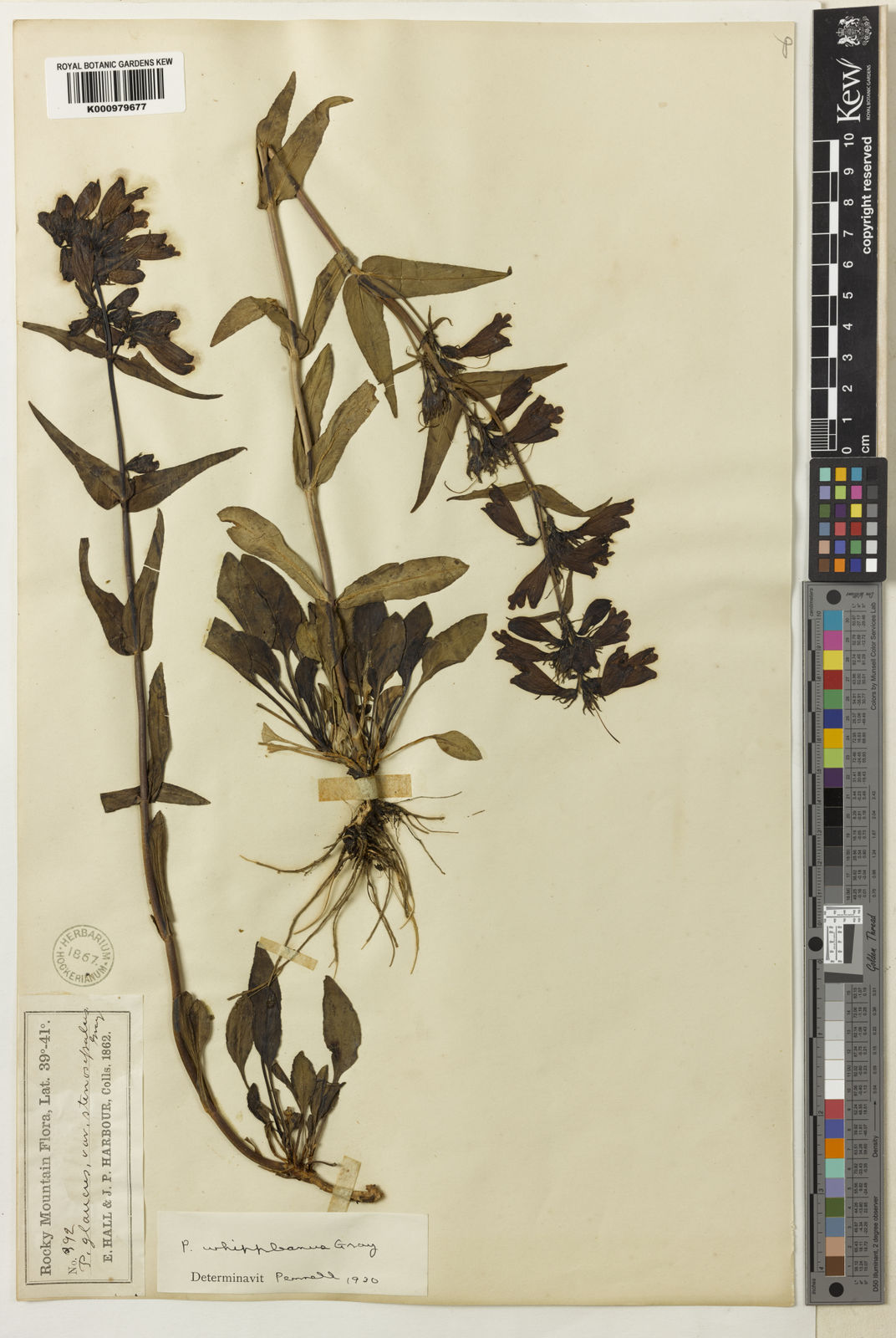Family: Plantaginaceae
Author: A.Gray
Bibliography: Proc. Amer. Acad. Arts 6: 73 (1862)
Year: 1862
Status: accepted
Rank: species
Genus: Penstemon
Vegetable: False
Observations: WC. U.S.A.
Description
Whipple’s penstemon, scientifically known as Penstemon whippleanus, is a captivating perennial herb belonging to the Plantaginaceae family. This enchanting plant, first documented by A.Gray in 1862 in the Proceedings of the American Academy of Arts and Sciences, is native to the western regions of the United States, an area blessed with a myriad of unique flora.
Characteristically, Whipple’s penstemon stands out in the wild due to its striking floral display. The flowers typically bloom in shades ranging from deep violet to lavender, occasionally exhibiting hues of white or pink. Each blossom is tubular and elongated, facilitating its role in attracting pollinators such as bees and hummingbirds. These flowers are borne on stout, leafy stems that often reach heights of up to 60 centimeters, creating a majestic and colorful spectacle in their natural habitat.
The leaves of Penstemon whippleanus are another noteworthy feature. They are lance-shaped, arranged oppositely along the stems, and possess a slightly toothed margin that enhances their textured appearance. This foliage, coupled with the plant’s robust root network, contributes to its resilience in a variety of climatic conditions, particularly in the semi-arid regions where it predominantly thrives.
One of the remarkable ecological contributions of Whipple’s penstemon is its role in supporting local wildlife. It provides nectar for pollinators and acts as a food source for some herbivorous insects. Additionally, it helps in stabilizing soil in fragile ecosystems, reducing erosion and promoting biodiversity in its native regions.
Whipple’s penstemon is not only admired for its aesthetic and ecological value but also holds significance in the field of horticulture. Gardeners and plant enthusiasts cultivate this species for ornamental purposes, where it is often used in rock gardens and native plant landscapes. Its relatively low maintenance and attractiveness to pollinants make it a favored choice among those looking to add a touch of the wild, rugged beauty of the western U.S.A. to their gardens.
In conclusion, Whipple’s penstemon is a perennial gem that embodies both the delicate beauty and hardy nature of its native landscape. As a plant that supports its environment and provides picturesque blooms, it stands as a cherished species within the diverse botanical tapestry of the United States.
Common Names
Eng: whipple’s penstemon
Swe: dysterpenstemon
En: Whipple’s penstemon, Dark Beardtongue, Dark purple penstemon
Fi: Arizonanpipo
Sv: Dysterpenstemon
Synonyms
- Penstemon arizonicus (A.Heller)
- Penstemon pallescens (Osterh.)
- Penstemon stenosepalus ((A.Gray) Howell)
- Penstemon glaucus var. stenosepalus (A.Gray)
Distribution
- Arizona (native)
- Colorado (native)
- Idaho (native)
- Montana (native)
- New Mexico (native)
- Utah (native)
- Wyoming (native)
Additional Images
Flower
Taken Sep 18, 2015 by EOL − Barry Breckling (cc-by-nc-sa)
Taken Aug 31, 2015 by EOL − Barry Breckling (cc-by-nc-sa)
Taken Dec 6, 2009 by EOL − Gary A. Monroe (cc-by-nc)
Taken Sep 16, 2015 by EOL − Barry Breckling (cc-by-nc-sa)
Taken Jul 25, 2022 by Laurie Van Egeren (cc-by-sa)
Leaf
Taken Jul 15, 2020 by T Trista (cc-by-sa)
Taken Aug 17, 2020 by Prescott Bergh (cc-by-sa)
Taken Dec 6, 2009 by EOL − Gary A. Monroe (cc-by-nc)
Habit
Taken Sep 11, 2014 by EOL − Fluff Berger (cc-by-sa)
Taken Mar 9, 2013 by EOL − Gary A. Monroe (cc-by-nc)
Taken Sep 13, 2015 by EOL − Barry Breckling (cc-by-nc-sa)
Taken Sep 13, 2015 by EOL − Barry Breckling (cc-by-nc-sa)
Taken Sep 18, 2015 by EOL − Barry Breckling (cc-by-nc-sa)

© copyright of the Board of Trustees of the Royal Botanic Gardens, Kew.
Sources
- WFO (No URL)
- IPNI (No URL)
- GBIF (https://www.gbif.org/species/3171516)
- POWO (http://powo.science.kew.org/taxon/urn:lsid:ipni.org:names:808349-1)
- PlantNet (https://identify.plantnet.org/species/the-plant-list/Penstemon whippleanus A. Gray)
Specifications
Growth form>: Multiple Stem
Growth habit>: Subshrub, Forb/herb
Growth rate>: Rapid
Growth
Ph maximum: 8.0
Ph minimum: 7.0













